Fungi & Lichen fact sheet
Fungi - Lichen
Review - kingdom, phylum, class, order, family genus, species
Introduction
This article reviews information about fungus and lichen. What they are, do, their benefits and hazards.
Fungi
History
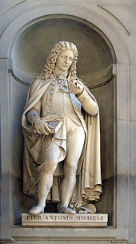
Pier Antonio Micheli wanted to prove spores from a fungus would make more fungi.
So he put spores, from a fungus, on a slice of melon and found they grew more fungi.
Thus proving fungi did not grow spontaneously, like others believed at the time.
What do fungi do?
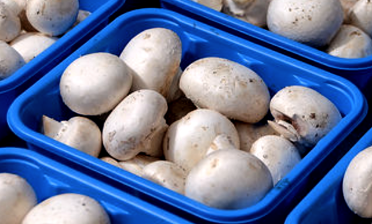
Fungi are every where on Earth. They can decompose all organisms and their hyphae push through all soils and create massive mycelium systems that form and enrich soil.
Fungi get their energy by dissolving their food (plant, bacteria, animal, or other fungus matter) outside their body and absorbing the dissolved nutrients with threadlike hyphae. They do not use photosynthesis.
There are a couple of reasons you don't notice most fungi:
First, most are so small you need a microscope to see them, like mold and baker’s yeast. They are so small 3,000 could fit on this period.
Second, hyphae, which makes up most of each fungus is about 1/10 the thickness of a human hair and collectively they make a network called a mycelium. Squeeze a clump of your hair and it is 10 times thicker than a mycelium (network) for a mushroom. Which is below the surface of the ground of any mushroom you see.
The part of the mushroom you see is its fruiting body. Like an apple on an tree. However, if the apple were the fruiting body of the mushroom, then it would be sitting on the ground with the rest of the tree underground.
These fruiting bodies produce spores, which need organic matter and water to grow. If spores fall on leaves, twigs, bugs, pizza crust; along with some moisture, then they will send out hyphae into the material and secrete enzymes to digest it into amino acids, which they will then absorb for energy to keep on growing. As long as the sense food, they will grow.
Molds like mushrooms grow and produce spores, but without fruiting bodies like mushroom caps. Their spores are produced at the ends of their hyphae and are released into the air by the millions. Most don’t cause problems for humans, but some can cause respiratory (breathing) problems, allergies or severe illnesses.
Spores are microscopic and can travel long distance through air, water, or with animals.
While most fungi reproduce with spores, yeasts reproduce with buds and mitosis (cellular division into two).
Classification information
Fungi are classified in their own kingdom because:
- They are like plants and animals in that they are eukaryotic, have a nucleus in every cell.
- They are different from plants in that they do not use photosynthesis & their cell walls are made of chitin like some arthropods. Not cellulose like plants.
- They are different than animals in that they don’t move, so they are given their own kingdom (plants, animals, fungi, bacteria, virus).
Fungi uses
Fungi can be used in fermentation which is used in some food production and preservation. Check out: soy sauce, chocolate, cheeses,
Rust, smut, blight, rot, gray mold, Irish potato blight, thrush, ringworm, athlete’s foot, nail infections, respiratory disease.
Cordyceps attack insects, feeds on them until they are ready to fruit, then cause them to climb to the top of a plant or screen, then kills them and the fungi releases spores. If you notice a dead insect stuck to the top of … with a powdery white ring, you found one.
As medicine
- Penicillium - antibiotic,
- Statins - fight cholesterol,
- Lion’s mane - help immune system, maybe Alzheimer’s, cancer;
- Cyclosporine - suppress organ rejection; psilocybin - PTSD and reduce fear;
Fungi to fight stains in the laundry,
Fungi to help farmers control insects,
Fungi used to make packing material,
Used as dyes for fabric and yarn,
Termites and leaf cutters farm fungi to provide food. Trees and grasses depend fungi to decompose organic matter to supply nutrients. And some plants and trees exchange nutrients with other plants and trees as partners with fungi as a messenger service or delivery service.
Mushroom life cycle
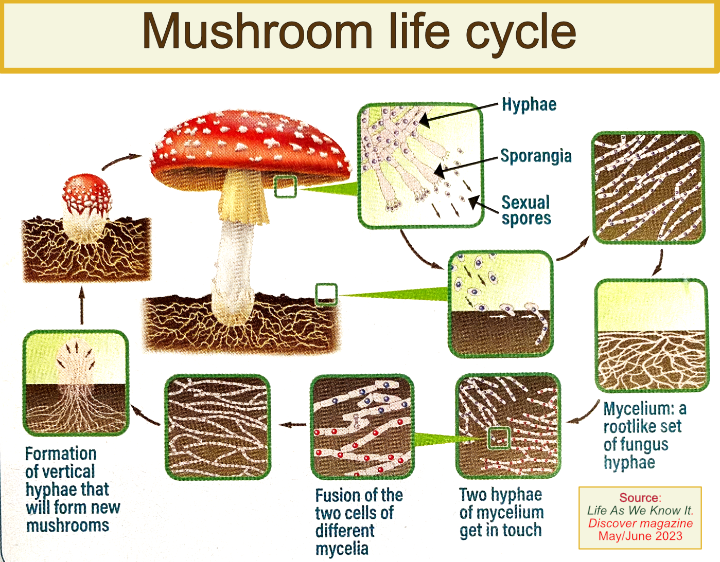
Some fungi phyla
Phylum Ascomycota
Ascomycota includes blue green molds like peniclllium, yeasts for bread and alcohol, morels, and truffles,
They have spores in pods called asci which release the spores when conditions are right.
Phylum Basidiomycota
Basidiomycota include club fungi with club shaped cells called basidia where each cell has four spores on the outside. And instead of being released, they fall off. Gilled mushrooms are of this phylum.
Phylum Chytridiomycota
Chytridiomycota are microscopic and live in moist or aquatic habitats. They are single celled and anchor to a food source. They produce spores with flagellum.
One species infects amphibians and has caused mass killings of frogs.
Mucoromycota microscopic molds that grow on or in plants, bread, fruits.
Microsporidia one-celled parasites that infect the gut, skin, and muscle of animals. Once thought to be protozoans, but found they have genes to make chitin. One species (Nosema ceranae infects honeybees.
Phylum Mucoromycota
Mucoromycota are microscopic molds that grow on or in plants, bread, fruits.
Microsporidia one-celled parasites that infect the gut, skin, and muscle of animals. Once thought to be protozoans, but found they have genes to make chitin. One species (Nosema ceranae infects honeybees.
Phylum Microsporidia
Microsporidia are one-celled parasites that infect the gut, skin, and muscle of animals. Once thought to be protozoans, but found they have genes to make chitin. One species (Nosema ceranae infects honeybees.
Lichen
Lichen are fungi and green algae or cyanobacteria that cooperate (symbiosis).
The fungi provide a habitat to protect the algae or cyanobacteria from heat, cold, and other environmental factors and the algae or cyanobacteria provide food for the fungi through photosynthesis.
Lichen can be found most everywhere. On trees, rocks, old buildings, and other structures. When you find some, spray it with some water and its colors will brighten.
They are very hardy and capable of living in extreme conditions. Their hypea can penetrate rock and other substances allowing them to be the first organisms to grow almost anywhere.
Types
- Fruticose lichens have lacy branches and filaments.
- Crustose have thick rough crusts with some having bright colors.
- Foliose lichens have leafy lobes and are greenish and grayish.
- Squamose lichens look like tiny shingles and can have leafy lobes or crusty growth.
- Filamentous lichens look like matted hair and smoothers can look like powder on a piece of bark.
Lichen photos
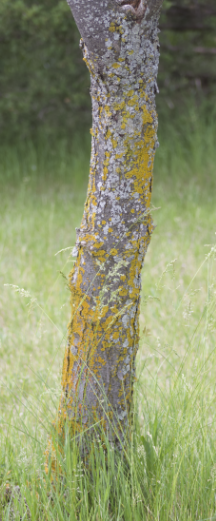
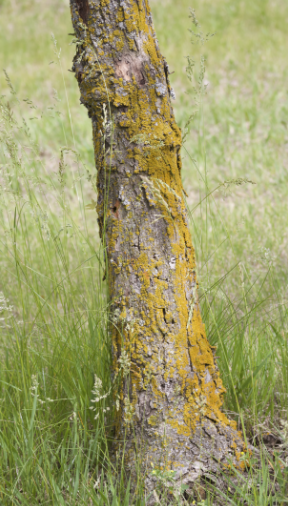
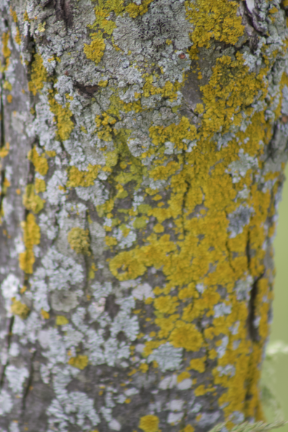
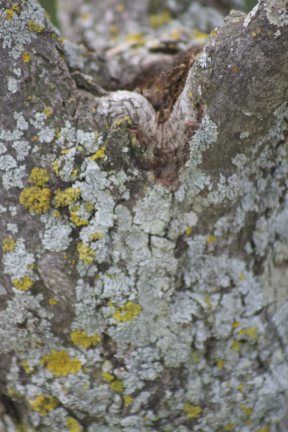
Activities with lichen & fungi
Fungi hunt & collection ideas
If you collect wild mushrooms be sure do so with supervision of an experienced collector.
Information to include:
- Date you found them
- Location you found them
- Were they on the ground or up off the ground? If so how high off the ground?
- What side of the object on which they are growing (north, south, east, or west).
- Was it alone or in clumps?
- What is nearby? other mushrooms or other fungi, moss, lichens, … around it.
- Are there insects, spiders, or other animals in the areas?
- Trees?
- Kinds of trees?
Take a picture and draw a diagram of it or them and write description that can include:
- How big it is, its shape, color, texture, smell,
- Its parts. Cap & stem.
- Their sizes?
- Color?
- Texture?
- Hollow?
- Does it have a sheath or ring?
- Is it attached to a stem? Or taper into the stem?
- Have gills or pores?
- Does it change color if lightly scratched?
- Does it have a liquid inside?
- Does the color change?
- Is the stem hollow or solid?
- Turn the mushroom to see under its cap.
- Find the gills and remove the tissue that protects them and look inside.
- What do you see?
- Cut the mushroom down the middle from the top to the bottom to make two mushroom halves.
- Twist the stem apart. Can you find the hyphae?
- Look at them with the hand lens.
Record your information on a page for each fungus.
Make compost
Materials
- 2 liter soda bottle, scissors, nail, plat dish to set the 2 liter bottle in
- Outside soil
- Shredded newspaper, dead leaves
- Spare bottle, organic matter, clippings, vegetable scraps, fruit peelings, egg shells, coffee grounds, tea bags.
- Marker
- Clothe
- Measuring tape
Directions
- Rinse the bottles, peel the labels, cut off the top, use a nail to make holes in the bottom and sides
- Stand it in the dish or tray.
- Add an inch of dirt, an inch of shredded newspaper and old leaves. Sara with water to make it damp, not soaked
- Add about the same amount of other organic matter as your leaves a paper. Spray with water.
- Add another layer of soil, leaves, paper. Then another layer of organic matter. Then top it off with some soil, grass, and leaves.
- Spray again.
- Draw a line to make the height of the compost.
- Place it in the sun and cover with the cloth.
- Record the date, a picture or drawing with what you added. The measurement of the height of the compost and continue to measure once a week and spray to maintain a fungus friendly environment.
You should end with the perfect soil for planting seeds.
Fungus spray
Materials
- 1 L water,
- 5 ml baking soda,
- 5 ml vegetable oil (so stick to leaves)
- two drops liquid soap (help stay mixed)
Directions
Put the ingredients into a spray bottle and shake until well mixed,
Then spray the top and bottom of leaves in early morning and and periodically on cloudy days.
Keep a spray schedule.
Powdery mildew and blight fungi don’t like this spray
Dissect a button mushroom:
Materials
- Lab notes or journal,
- pencils,
- button mushroom from grocery store,
- paper plate,
- plastic knife,
- magnifying glass,
- tweezers,
- ruler.
Directions
The safest mushrooms to dissect are obtained from a grocery store. For example button mushrooms. If you collect wild mushrooms be sure do so with supervision of an experienced collector.
- Draw a picture of your mushroom.
- Note how big it is, its shape, color, texture, smell,
- Notice its parts. Cap & stem.
- What are their sizes?
- Color?
- Texture?
- Hollow?
- Does it have a sheath or ring?
- Is it attached to a stem? Or taper into the stem?
- Have gills or pores?
- Does it change color if lightly scratched?
- Does it have a liquid inside?
- Does the color change?
- Is the stem hollow or solid?
- Turn the mushroom to see under its cap.
- Find the gills and remove the tissue that protects them and look inside.
- What do you see?
- Cut the mushroom down the middle from the top to the bottom to make two mushroom halves.
- Twist the stem apart. Can you find the hyphae?
- Look at them with the hand lens.
Draw what you have seen.
Spore prints
Materials
- Mushroom cap,
- knife,
- paper - half black & half white,
- glass bowl or cup,
- hand lens,
- fixative spray or hairspray (optional)
Directions
Put the mushroom cap gill side down on the paper (some spores are light and some dark so may want to use half white and half black paper)
- Put the cup or bowl over the cap.
- Wait overnight.
- Gently lift the cover and see a pattern.
- Draw the pattern and compare with others.
- Use a needle to transfer some of the spores to a glass slide, put a drop of water, and put on a cover slip. View with a microscope.
- Can fix the pattern to preserve it.
Grow a mold garden
Materials
- Left over food: bread, fruit, vegetables, Do not use any food containing meat, oil, or dairy - they will get very smelly after a day or two.
- CAUTION - some molds are not healthy to inhale. Do not open the lid of your garden to get a closer look. When done throw it in the garbage and don’t reuse the container.
Directions
- Chose 4-5 pieces of food.
- Cut then into grape sized chunks.
- Dip in water or spritz with water.
- Space them out in the container so they don’t touch.
- Put the lid on the container and tape it around the edges to seal it.
- Label it as mold garden and put it where no one will move it so you can observe it for a few days.
- Observe it every day. When there is growth take a picture or draw what it looks like.
- Questions to consider:
- What foods got moldy first?
- What color is the mold on each?
- Is it fuzzy,
- Are they plain color or spotted?
- Is there a pattern?
- How do they spread?
- When the food begins to rot, what happens to the mold?
- After a couple of weeks, take a final picture and throw the garden in the trash. Remember do NOT open!
Will grass compost in a pile/
Materials
- Lab book or journal
- Used chopsticks or skewers
- Permanent marker
- Masking tape
- Thermometer
- Ruler
- Place to pile grass
Directions
- Consider and decide what idea about grass clippings and fungi you want to explore. For example:
- One pile of grass, or multiple piles in different locations, or multiple piles of different depths of grass.
- One pile that varies in depth to say three inches.
- Find a permissible place to pile grass clippings
- Mark the spot with wood skewers and use masking tape to make and attach a flag label to with the date and location.
- Record that information in your lab book along with the amount of grass stacked in the areas.
- The Shape, Area, Depth
- Measure the temperature on the surface, different depths, and at bottom of the pile.
- Record what it looks like at each point.
- Check the clippings a couple of times a week. Note
- Did it rain?
- What was the high and low daily temperature
- What is happening to the grass on the surface.
- What’s happening to the lawn under the grass?
- What do you see? thin strands of fungi? Slimy grass …
- Other ideas to explore. What happens if you mix dead leaves with half the grass?
- What happens if the grass is dry before piling it up?
Resources
- Make an Origami mushroom
- Help with identification Oklahoma Mycological Society
- More outdoor activities
Science - Investigations, activities, & teaching plans: by dimensions of science